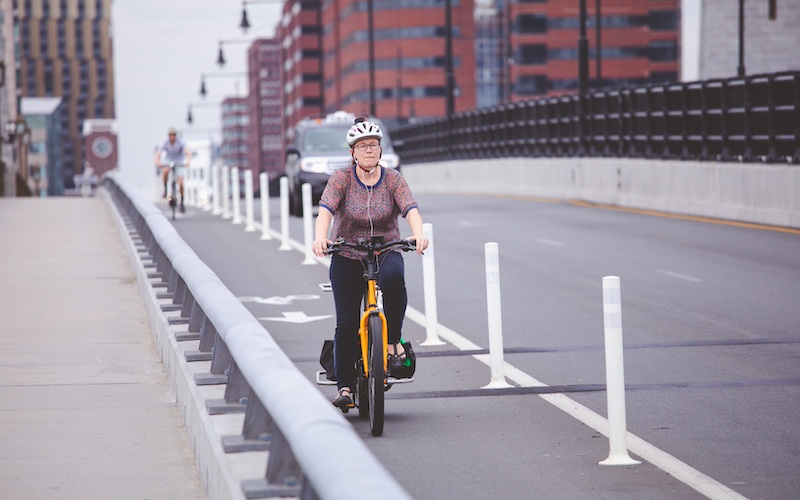
Recent fatal collisions in the Boston metro area show that there's room for improving bike infrastructure on city streets. Photo: Shutterstock
Since moving to Boston, one of my favorite ways of exploring the city is by bike. At first, I was pleasantly surprised by the number of protected bike lanes I found. Marked by posts or concrete dividers, they kept me separate from cars. However, far too often, I would turn onto a busy road to find only a single white line between me and speeding cars just inches away from my pedals. To add to my dismay was the drumbeat of news of cyclists injured or killed in vehicle collisions. In Cambridge recently, two cyclists died after crashes with trucks. Understandably, collisions like these are discouraging and keep many cyclists off the roads.
But it shouldn’t be this way. Biking and the infrastructure to support it should be an integral part of Boston’s climate and transit vision. They should go hand in hand with reducing carbon pollution and increasing transit equity.
Done right, biking infrastructure could enhance access to MBTA trains and buses while complementing the use of clean electric vehicles. Robust biking infrastructure could be the important glue to tie our transit system together, greatly reducing unhealthy pollution from the transportation sector, which is the highest carbon emitter. Unfortunately, here in Boston, this vision is still far from what it could be.
What does the current bike infrastructure look like in Greater Boston?
The existing bike infrastructure in Boston is inconsistent, disconnected, and inequitably distributed, presenting significant challenges that hinder its effectiveness as a viable alternative to cars or trains. One issue is the abrupt termination of bike lanes following intersections, especially closer to downtown, when roads narrow and congestion increases. This pushes cyclists from spacious protected zones into direct competition with cars and trucks—which is scary for experienced bikers, let alone those new to biking.
Moreover, new roads and transit developments have lacked corresponding improvements for bike lanes and traffic management. Even where lanes are designated as “protected,” they frequently fail to provide adequate safety. (This was true, for example, at both Cambridge intersections where collisions occurred this year.) Strengthening these transition areas, where vehicle and pedestrian traffic converges, has been shown to be a critical aspect of keeping bikers safe in places like the Netherlands or Minneapolis, both known for bike-friendly streets.
Another barrier is the limited storage options for bikes at public transit stations. This makes it harder to seamlessly transition from biking to T or bus use for longer commutes. Addressing these shortcomings requires comprehensive planning that prioritizes and expands biking infrastructure. If cycling was made safer and more appealing, more individuals could be encouraged to shift away from gas-dependent vehicles, increasing sustainable urban mobility.
Cycling safety must be prioritized in Environmental Justice communities
When planning new bike infrastructure, it’s crucial to consider which areas of the city need them most. Currently, most safe and protected lanes are concentrated in wealthier, less diverse neighborhoods. These areas also have the most MBTA routes and connections, limiting reliable mobility options for those in lower-income neighborhoods. Especially in underserved regions, existing infrastructure fails to integrate with existing transit routes, missing opportunities to enhance connectivity between stations and stops. Organizations like the Boston Cyclists Union urge city planners to change this by prioritizing the experiences of underrepresented bicyclists and ensuring biking accessibility for all riders—whether they’re e-bike users, casual riders, commuters, parents hauling kids, pedicabs, or more. Their mission underscores the belief that everyone should have the resources and choice to navigate Boston’s streets safely and freely by bike.
Bike share programs such as Boston Bluebikes are another important way of increasing bike ridership in all city areas and demographics. Ridership skyrockets when MBTA routes are closed or delayed, proving people realize their benefits.
Bike-Friendly Multimodal Projects
CLF is committed to making biking infrastructure an indispensable part of a comprehensive solution to pollution and congestion. Biking must be part of the equation when new projects are planned and built. CLF is pushing for enhanced bike infrastructure in MBTA projects like the Red-Blue Connector and the Somerville Safe Streets Ordinance, which calls for adding 30 miles of protected bike lanes by 2030.
We also aim to keep biking front and center before the Massachusetts Department of Transportation (MassDOT). Our goal is for 75 percent of Massachusetts residents and jobs to be within a 5-minute walk of separated bike lanes. By 2030, those separated paths should be part of an interconnected tapestry linking businesses with residential areas. MassDOT should also develop a detailed timeline and interim steps for achieving its Vision Zero goal of zero deaths or serious injuries on all Massachusetts roadways by 2050. Finally, we must also increase funding and expansion of bike-share programs, particularly in underserved areas that currently lack them. We aim to prioritize sustainable transportation options and reduce overall vehicle use and unhealthy emissions across the region.
Making Biking a Viable Option
Fostering a future where biking and sustainable transit are viable choices for all Bostonians requires continued investment in infrastructure that supports a cleaner, safer, and more equitable urban environment. You can contribute to and support these initiatives by urging legislators to push for funding for all types of transportation infrastructure.
The work is not done until Greater Boston is fully connected by an infrastructure network that gives everyone the choice and resources to bike freely and safely through the streets. While I will only be in Boston for a little longer, I hope that when I return to the city, I’ll find safer streets that encourage more residents to get out of their cars and onto their bikes.
Sylva Das is a student at Wellesley College. She was a Clean Energy and Environmental Justice intern with Conservation Law Foundation’s Boston office in the summer of 2024.



